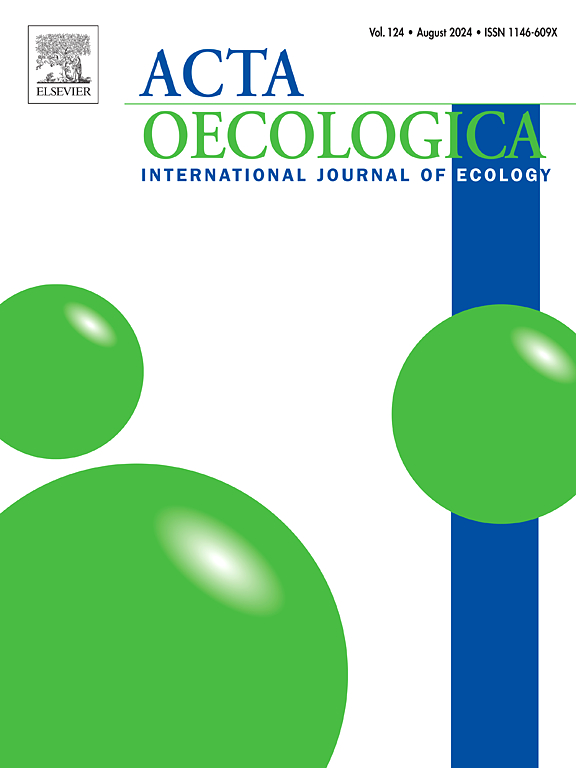Unveiling the association of mangrove flowering phenology on the dynamics of insect abundance
IF 1.3
4区 环境科学与生态学
Q3 ECOLOGY
Acta Oecologica-International Journal of Ecology
Pub Date : 2024-12-14
DOI:10.1016/j.actao.2024.104052
引用次数: 0
Abstract
Mangroves are ecologically unique ecosystems supporting large biodiversity. Climate change and anthropogenic interferences led to continuous decline of mangroves worldwide. Simultaneously, continuous decline in pollinators, have put these primarily insect-pollinated ecosystems under threat. Therefore, to understand seasonal and interannual variation in floral-visitor population, study of insect-visitor abundance in relation to flowering phenology is critical. In this context, present study (2022–2023) was conducted in the mangrove belt of Purba Medinipur, West Bengal, India. We observed quantitative floral availability as flowering phenology of four dominant mangrove species: Avicennia marina, Avicennia officinalis, Aegiceras corniculatum, and Acanthus ilicifolius. We also examined the seasonal and interannual variation in insect abundance within the mangrove community via pan traps. To identify potential pollinator groups among insects from the pan traps, we studied foraging behaviour of these insect visitors separately. Finally, we investigated the relationship between floral availability and insect-visitor abundance.
In this study, a total 35 insect species of eight orders were collected across all pan traps, among which, 19 species were classified as potential pollinators. Hymenoptera was most abundant in pan trap captures, followed by Diptera, Lepidoptera and Coleoptera. Significantly higher insect abundance was observed during the peak flowering at community-level. There was no interannual variation in insect abundance between two years. This is the first comprehensive quantitative study identifying potential mangrove pollinators and demonstrating their positive relationship with floral availability, which affecting pollinator abundance. This also indicates that, steady supply of floral availability is required for maintaining the pollinator abundance in the community.
揭示红树林开花物候与昆虫丰度动态的关系
红树林是生态上独特的生态系统,支持大量生物多样性。气候变化和人为干扰导致全球红树林持续减少。同时,传粉媒介的持续减少,使这些主要由昆虫授粉的生态系统受到威胁。因此,研究昆虫访鸟丰度与开花物候的关系是了解花访鸟种群的季节和年际变化的关键。在此背景下,本研究(2022-2023)在印度西孟加拉邦Purba Medinipur红树林带进行。本研究利用开花物候特征对4种优势红树种Avicennia marina、Avicennia officinalis、Aegiceras corniculatum和Acanthus ilicifolius进行了定量的花可用性研究。我们还利用捕集器研究了红树林群落昆虫丰度的季节和年际变化。为了确定盘式陷阱昆虫中潜在的传粉者群体,我们分别研究了这些昆虫的觅食行为。最后,研究了花的可用性与访虫丰度之间的关系。本研究共采集昆虫8目35种,其中潜在传粉昆虫19种。捕集器捕获物以膜翅目最多,其次为双翅目、鳞翅目和鞘翅目。在群落水平上,昆虫丰度在开花高峰期显著增加。2年之间昆虫丰度无年际变化。这是第一次全面的定量研究,确定了潜在的红树林传粉媒介,并证明了它们与影响传粉媒介丰度的花可用性之间的正相关关系。这也表明,稳定的花卉供应是维持群落中传粉者丰度的必要条件。
本文章由计算机程序翻译,如有差异,请以英文原文为准。
求助全文
约1分钟内获得全文
求助全文
来源期刊
CiteScore
3.60
自引率
0.00%
发文量
57
审稿时长
>0 weeks
期刊介绍:
Acta Oecologica is venue for the publication of original research articles in ecology. We encourage studies in all areas of ecology, including ecosystem ecology, community ecology, population ecology, conservation ecology and evolutionary ecology. There is no bias with respect to taxon, biome or geographic area. Both theoretical and empirical papers are welcome, but combinations are particularly sought. Priority is given to papers based on explicitly stated hypotheses. Acta Oecologica also accepts review papers.

 求助内容:
求助内容: 应助结果提醒方式:
应助结果提醒方式:


